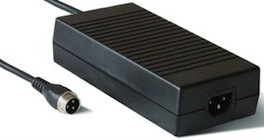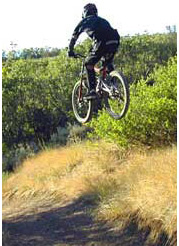Site Map FAQ Link Contact About
Charger Electric Bicycle

Electric chargers are used for recharging the battery. There are different kinds of chargers which are suitable for different batteries.
Every new electric bicycle should come with it's own designated charger.
Proper charing will ensure a long battery life.
Charging Sequence
- Plug the charger to the battery, and then plug it to the wall outlet.
- While charging, the light indicator of the charger is red, when it turns green, the battery is fully charged and you can stop charging.
- When charging is complete, unplug the charger from the wall outlet and then disconnect the charger from the battery.
Plugging in the charger will recharge the battery to full capacity at any time. You can partially charge and disconnect the battery even if the green light has not come on and use the battery, just be aware that you will not have a full charge capacity.
You can charge the battery when it disconnected from the e-bike, and you can charge the battery when it connected to the bike - just be sure that the e-bike is not turned on.
Battery Storage
Leaving the electric bike battery in a partially discharged state for long periods of time shortens the battery lifetime.
When the electric bike is not being used for a long stretch of time, it is important to recharge the battery periodically. The exact periods vary from one battery type to another.
Battery Management System
The Battery Management System (BMS) is basically a computer chip which optimizes the operation of the battery. Some battery types oftentimes have a BMS while other types rarely have it.
The BMS is located inside the charger (or inside the battery). Among it's line of features are maximizing the battery lifetime by diagnosing and monitoring the battery, optimizing charging time, limit charging current levels to ensure the charger won't over charge the battery and preforming a balancing check between the different cells inside the battery.
Simple chargers tend to heat the battery to unnecessary levels while taking a longer time to complete the charging process. Unnecessarily, it can cause damage to the battery. More advanced chargers with a BMS chip reduce the risk of damage to a minimum.
Temperature
The charger can become quite hot while charging. Earlier chargers had no integral fan and always got hot.
A charger design which have a tiny integral fan keeps the air moving out and keeping the charger cooler.
Although the charger can get quite hot, the battery itself shouldn't get hot usually (depends on battery type).
Safety
With moderns batteries and chargers, leaving the battery on charge won't harm it, it's only on safety grounds that they are best not left unattended.
Once the battery is fully charged, the charger (if functioning properly) switch to an idle mode or trickle mode. The suggestion is to unplug the charger once the battery becomes fully charged. And in any case, you should avoid keeping the charger plug in for more than a few hours after the battery is full.
If you want to be extra cautious, you can use a timer and set it to stay on for the estimated duration of the charging.
Some chargers can become quite hot while charging, especially the ones that aren't internally cooled. Internally cooled chargers or those that charge at slow rates are more secure. Also, charging the battery in a fanned place, away from heat and fire is safer.
Don't store the charger close to water or other liquids. Don't try to disassemble the charger. Don't wash the charger with detergents (use a dry duster instead). Don't use a defected, damaged or somewhat twisted charger. Don't use the electric bicycle charger to charge other electrical devices batteries and don't use other electric devices charges to charge the electric bicycle battery.
The charger can serve you properly for a very long time, just be sure to maintain it properly. Also, the charger (and the battery) is usually not covered by warranty in a case of misusing.
If you accidentally lose the charger or damage it, it is smart to ask your dealer for a replacement. Avoid using a cheap substitute, it’s likely to cause damage to the battery.
Don't buy a new electric bicycle which doesn't has a charger coming with it. Chargers are designed specifically for a specific battery. Every new electric bicycle should come with it's own designated charger and it should raise a red flag if the charger is missing.
Charger Types
We can divide the chargers types to four sub-categories. There are chargers that combine the properties of more then one sub-category.
Simple charger
Smart charger
Fast charger
Pulse charger
How long does it take to charge the battery?
Theoretically, the battery can be charged in minutes. But, in real life scenarios, most batteries have to be charged for a couple of hours until they are full charged.
Why is that?
Batteries do not take kindly to fast charging. The faster the charging, the shorter the battery lifetime.
As a rule of thumb, if you want to prolong and preserve the life of the battery, the slower the charger charges the battery, the better.
But, in broader perspective, different kinds of batteries behaves differently under different charging conditions.
Nickel batteries, for example, are more tolerant to fast charging then lead-acid batteries.
But, what if you want to charge faster?
In such case, modern fast chargers manage to shorten the charging time while not affecting the battery longevity so much. A fast charger makes a great difference to the flexibility of the electric bicycle. You can, for example, ride for the full range in one direction, recharge while in your place of destination, and return home later on with full charged battery.
But, nevertheless, an overnight charging is the safest and kindest to the battery. A sound advise will be to use a slow charger for overnight charging and a faster charger for days when the e-bike is being ridden for more then one battery cycle range.
Charger Ah
A 2Ah charger put 2Ah worth of energy into the battery every in 1 hour.
In an ideal case, a 10Ah empty battery pack will be charged in 5 hours by using such a charger. However, to prolong the life of the battery, the charging is usually fast in the beginning and slow down in later stages(depends on charger types.)
The BMS (if exist) slows down the charge rate once a certain point of charging capacity is accomplished. The battery in this stage is almost completely charged. The charger light indicator would still be red but the charger's fan will usually not work and it will feel cool.
It is OK to stop the charging and use the battery if you are in a hurry. But be sure to do full charge cycles frequently.
Power sources
The electric bicycle charger standard power-source is the wall AC socket. But, because of the very low power demands of a typical e-bike, other alternative sources of energy can also become handy.
Solar, wind, air and regenerative braking are 4 kinds of such alternative energy sources. You are welcome to click on any one of them to get further information.
Return from Charger Electric Bicycle to Electric Bicycle Guide
|









New! Comments
Have your say about what you just read! Leave me a comment in the box below.